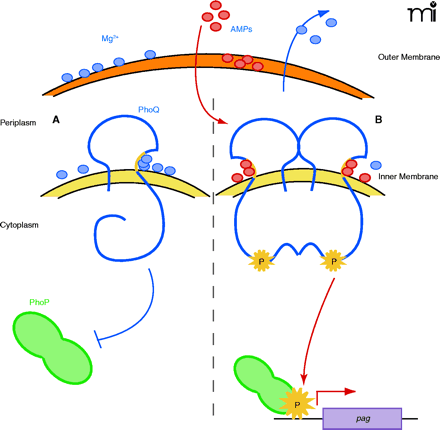
- Institution: Stanford Univ Med Ctr Lane Med Lib/Periodical Dept/Rm L109
- Sign In as Member / Individual
A Bacterial Sensory System that Activates Resistance to Innate Immune Defenses: Potential Targets for Antimicrobial Therapeutics

The interaction of magnesium and AMPs with theSalmonella entericaPhoP-PhoQ two-component regulatory system. PhoP-PhoQ is required for survival in the presence of low magnesium, antimicrobial peptides [(AMPs), i.e., PB, PG-1, CRAMP, and LL-37], cultured macrophages, and within animal hosts. Both magnesium ions (blue ovals) and AMPs (red ovals) are thought to bind an acidic pocket in the periplasmic domain of PhoQ at the inner membrane interface (yellow patch). Millimolar concentrations of magnesium repress the PhoP-PhoQ system (A), whereas sublethal concentrations of AMPs displace magnesium and activate this system (B). Administering AMPs to bacteria leads to loss of Mg2+ ions from the bacterial membrane as well as from PhoQ itself. Activation of PhoQ is the result of a conformational change in the PhoQ protein that promotes dimerization and autophosphorylation, with subsequent phosphotransfer to the DNA response regulator, PhoP. Phospho-PhoP activates transcription of a number of genes (pag) that promote survival of Salmonella enterica in the host.


